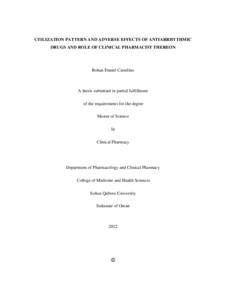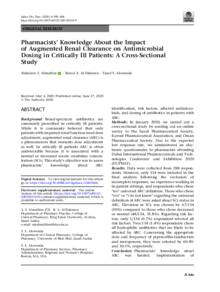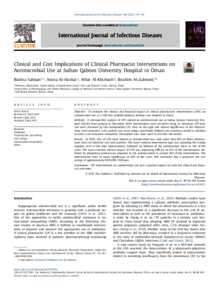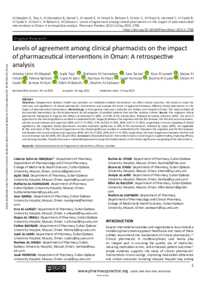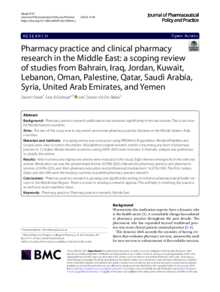Document
Utilization pattern and adverse effects of antiarrhythmic drugs and role of clinical pharmacist thereon.
Other titles
نمط الاستخدام والآثار الضارة للأدوية المضادة لاضطراب النظم ودور الصيدلي السريري في هذا الشأن
Publisher
Sultan Qaboos University.
Gregorian
2022
Language
English
English abstract
Background: Although antiarrhythmic drugs are effective at preventing arrhythmias and reducing
the associated symptoms, they carry a considerable risk of proarrhythmias among other toxic
effects, that warrants their judicial use and careful monitoring. Clinical pharmacists play an
important role in resolving and preventing drug therapy problems through their interventions. The
aim of the study was to describe prescribing trends and resulting adverse effects of antiarrhythmic
drugs at Sultan Qaboos University Hospital, and to analyze clinical pharmacist interventions in
antiarrhythmic drug management in terms of drug therapy problems, intervention rate, physician
acceptance and clinical significance.
Methods: This was a retrospective observational study that was carried out by reviewing
electronic patient records of adult patients (≥18 years) who received at least one dose of the
available antiarrhythmic drugs (procainamide, lidocaine, flecainide, atenolol, bisoprolol,
carvedilol, esmolol, propranolol, amiodarone, sotalol, diltiazem, verapamil, adenosine, digoxin
and magnesium sulphate) for any arrhythmia at Sultan Qaboos University Hospital during the
study period from January 2020 to December 2021.
Results: A total of 400 patients were enrolled. The overall mean age of the cohort was 62.5 ± 16.6
years ranging from 19 to 96 years with 55.3% (221/400) of the patients being male. Atrial
arrhythmias consisting of atrial fibrillation and atrial flutter were the most common types of
arrhythmias observed (313/400, 78.3%). The majority of the prescriptions were beta-blockers
(337/500, 67.4%) with bisoprolol particularly being the highest prescribed antiarrhythmic drug
(262/500, 52.4%) at a dose of 5 mg once-daily (111/500, 22.2%) followed by carvedilol (64/500,
12.8%) and amiodarone (58/500, 11.6%). Class III (60/500, 12%) and the miscellaneous agents
(48/500, 9.6%) were the second and third most prescribed AADs respectively. Class IV agents
(18/500, 3.6%) were the least prescribed AADs. Monotherapy was prescribed for 75% (300/400)
of the patients and dual therapy for 25% (100/400) of the patients. A total of 109 adverse effects
were documented for 86 prescriptions in 20.5% (82/400) of the patients. Considering the adverse
effects due to the patients' most recent prescriptions only, a total of 57 adverse effects were noted
for 45 prescriptions in 45 patients, resulting in an overall incidence of 9% (45/500). Among the
various classes of antiarrhythmic drugs, amiodarone (Class III) was responsible for the highest
incidence of adverse effects (9/60, 15%), followed by miscellaneous antiarrhythmic drugs (7/48,
14.6%). Cardiovascular adverse effects comprised the majority of the reported adverse effects
(41/109, 37.6%) with bradycardia being the most common complication (27/109, 24.8%) caused
by beta-blockers (n=17), amiodarone (n=5) and digoxin (n=5). Risk factors associated with
adverse effects included patients with coronary artery disease (18.6% vs. 31.7%; p=0.015) and
those who were on antiarrhythmic drug therapy for more than 10 years (4.1% vs. 9.6%; p=0.045).
A total of 122 clinical pharmacist interventions were recorded in 13% (52/400) of the patients.
Beta-blockers were associated the highest number of interventions (61/122, 50%) with both
bisoprolol and carvedilol being responsible for 28 prescriptions each. Patients with older age
(61.84 years vs. 66.75 years; p=0.047), co-morbidities (83.6% vs. 96.2%; p=0.019), the presence
of renal impairment (19.6% vs. 40.4%; p=0.001) or heart failure (11.8% vs. 28.9%; p=0.002), those
vii
with concomitant medications (84.5% vs. 98.1%; p=0.004), polypharmacy (51.1% vs. 69.2%;
p=0.022) and those who received antiarrhythmic drug therapy for a period of less than one year
(9.3% vs. 27.3%; p<0.001) were significantly associated with a greater need for intervention
compared to those patients who did not have these risk factors.
Conclusion: Antiarrhythmic drugs from all classes were used to treat various kinds of arrhythmias
at Sultan Qaboos University Hospital. Beta-blockers (Class II) were the most commonly
prescribed antiarrhythmic drugs. Amiodarone (Class III) was associated with the highest incidence
of adverse effects in the utilization period. The safe and effective use of antiarrhythmic drugs was
aided by clinical pharmacist interventions.
Member of
Resource URL
Arabic abstract
الخلفية: على الرغم من أن الأدوية المضادة الضطراب النظم فعالة في الوقاية من عدم انتظام ضربات القلب وتقليل
الأعراض المصاحبة لها ، الأ أنها تنطوي على مخاطر كبيرة من عدم انتظام ضربات القلب من بين التأثيرات السامة الأخرى
والتي تستدعي استخدامها القضائي والمراقبة الدقيقة. يلعب الصيادلة السريريون دو ًرا مه ًما في حل مشاكل العلاج الدوائي ،
والوقاية منها من خلال تدخالتهم. كان الهدف من الدراسة هو وصف اتجاهات الوصفات والأثار السلبية الناتجة عن الأدوية
المضادة الضطراب النظم في مستشفى جامعة السلطان قابوس ، وتحليل تدخالت الصيدلي السريري في إدارة الأدوية
المضادة الضطراب النظم من حيث مشاكل العلاج الدوائي ، ومعدل التدخل ، وقبول الطبيب والأهمية السريرية
الطريقة: كانت هذه دراسة قائمة على الملاحظة بأثر رجعي تم إجراؤها من خلال مراجعة سجلات المرضى الألكترونية
للمرضى البالغين )أكبر من 18 عا ًما( الذين تلقوا جرعة واحدة على الأقل من الأدوية المتاحة لعدم انتظام ضربات القلب
، بروكاييناميد ، ليدوكائين ، فليكاينيد ، أتينولول ، بيسوبرولول ، كارفيديلول ، إسمولول ، بروبرانولول ، أميودارون(
سوتالول ، ديلتيازيم ، فيراباميل ، أدينوزين ، ديجوكسين وكبريتات المغنيسيوم( ألي عدم انتظام ضربات القلب في مستشفى
جامعة السلطان قابوس خلال فترة الدراسة من يناير 2020 إلى ديسمبر 2021
النتائج: تم تسجيل ما مجموعه 400 مريض. كان متوسط العمر الأجمالي للفوج 62.5 ± 16.6 سنة تتراوح من 19 إلى 96
سنة مع 55.3 ٪ )221/400( من المرضى هم من الذكور. كانت حالأت عدم انتظام ضربات القلب المكونة من الرجفان
الأذيني والرفرفة الأذينية هي أكثر أنواع عدم انتظام ضربات القلب شيوعًا )313/400 ، ٪78.3(. ك انت غالبية الوصفات
الطبية عبارة عن حاصرات بيتا )337/500 ، ٪67.4( مع بيسوبرولول بشكل خاص وهو أعلى دواء موصوف من مضادات
، اضطراب النظم )262/500 ، ٪52.4( بجرعة 5 مجم مرة واحدة يوميًا )111/500 ، ٪22.2 ( يليه كارفيديلول )64/500
وأميودارون )58/500 ، ٪11.6(. كانت الفئة الثالثة )60/500 ، ٪12( والعوامل المتنوعة )48/500 ، ٪9.6( )12.8٪
ثاني وثالث أكثر الأدوية الموصوفة على التوالي. وكلاء الفئة الرابعة )18/500 ، ٪3.6( كانوا أقل الأدوية الموصوفة
للعقاقير الموصوفة. تم وصف العلاج الأحادي لـ ٪75 )300/400( من المرضى والعلاج المزدوج لـ ٪25 )100/400( من
المرضى. تم توثيق ما مجموعه 109 آثار ضائرة لـ 86 وصفة طبية في 20.5 ٪ )82/400( من المرضى. بالنظر إلى الأثار
ًرا لـ 45 وصفة طبية في 45
الضارة الناجمة عن أحدث الوصفات الطبية فقط للمرضى ، لوحظ ما مجموعه 57 تأثي ًرا ضا
مري ًضا ، مما أدى إلى حدوث 9 ٪ )45/500(. من بين الفئات المختلفة من الأدوية المضادة الضطراب النظم ، كان
الأميودارون )الفئة الثالثة( مسؤوالً عن أعلى نسبة من الأثار الضارة )9/60 ، ٪15( ، تليها الأدوية المتنوعة المض ادة
الضطراب النظم )7/48 ، ٪14.6(. تضمنت التأثيرات الضائرة القلبية الوعائية غالبية التأثيرات الضائرة المبلغ عنها
مع كون بطء القلب هو المضاعفات الأكثر شيوعًا )27/109 ، ٪24.8( التي تسببها حاصرات بيتا )ن )37.6٪ ، 41/109(
أميودارون )ن = 5 ( والديجوكسين )ن = 5(. تضمنت عوامل الخطر المرتبطة بالأثار الضائرة مرضى الشريان ، )17 =
وأولئك الذين كانوا يخضعون للعالج بالعقاقير المضادة الضطراب النظم ألكثر )0.015 = p ٪18.6 مقابل ٪31.7 ؛( التاجي
٪ تم تسجيل ما مجموعه 122 تدخل صيدلي سريري في 13 .)0.045 = p ٪4.1 مقابل ٪9.6 ؛( من 10 سنوات
من المرضى. ارتبطت حاصرات بيتا بأكبر عدد من التدخلات )61/122 ، ٪50( مع كون كل من بيسوبرولول )52/400(
، )0.047 = P ، 61.84 سنة مقابل 66.75 سنة( وكارفيديلول مسؤوالن عن 28 وصفة لكل منهما. المرضى كبار السن
)0.001 = p ، ٪19.6٪ مقابل 40.4( وجود اختالل كلوي ، )0.019 = p ، ٪83.6٪ مقابل 96.2( حالأت أمراض مشتركة
p أولئك الذين يعانون من الأدوية المصاحبة )٪84.5 مقابل ٪98.1 ؛ ، )0.002 = p ٪11.8 مقابل ٪28.9 ؛( أو فشل القلب
وأولئك الذين تلقوا ارتبط العلاج الدوائي المضاد )0.022 = p ٪51.1 مقابل ٪69.2 ؛( تعدد الأدوية ، )0.004 =
بشكل كبير بالحاجة الأكبر للتدخل مقارنةً )0.001> p ٪9.3 مقابل ٪27.3 ؛( الضطراب النظم لفترة أقل من سنة واحدة
بالمرضى الذين لم تكن لديهم عوامل الخطر هذه
الخلاصة: تم استخدام الأدوية المضادة لاضطراب النظم من جميع الفئات لعلاج أنواع مختلفة من عدم انتظام ضربات القلب
في مستشفى جامعة السلطان قابوس. كانت حاصرات بيتا )الفئة الثانية( أكثر الأدوية المضادة الضطراب النظم شيوعًا التي
يتم وصفها. ارتبط الأميودارون )الفئة الثالثة( بأعلى نسبة من الأثار الضارة في فترة الأستخدام. ساعدت التدخلات
الصيدلانية السريرية على الأستخدام الأمن والفعال للادوية المضادة لاضطراب النظم
الأعراض المصاحبة لها ، الأ أنها تنطوي على مخاطر كبيرة من عدم انتظام ضربات القلب من بين التأثيرات السامة الأخرى
والتي تستدعي استخدامها القضائي والمراقبة الدقيقة. يلعب الصيادلة السريريون دو ًرا مه ًما في حل مشاكل العلاج الدوائي ،
والوقاية منها من خلال تدخالتهم. كان الهدف من الدراسة هو وصف اتجاهات الوصفات والأثار السلبية الناتجة عن الأدوية
المضادة الضطراب النظم في مستشفى جامعة السلطان قابوس ، وتحليل تدخالت الصيدلي السريري في إدارة الأدوية
المضادة الضطراب النظم من حيث مشاكل العلاج الدوائي ، ومعدل التدخل ، وقبول الطبيب والأهمية السريرية
الطريقة: كانت هذه دراسة قائمة على الملاحظة بأثر رجعي تم إجراؤها من خلال مراجعة سجلات المرضى الألكترونية
للمرضى البالغين )أكبر من 18 عا ًما( الذين تلقوا جرعة واحدة على الأقل من الأدوية المتاحة لعدم انتظام ضربات القلب
، بروكاييناميد ، ليدوكائين ، فليكاينيد ، أتينولول ، بيسوبرولول ، كارفيديلول ، إسمولول ، بروبرانولول ، أميودارون(
سوتالول ، ديلتيازيم ، فيراباميل ، أدينوزين ، ديجوكسين وكبريتات المغنيسيوم( ألي عدم انتظام ضربات القلب في مستشفى
جامعة السلطان قابوس خلال فترة الدراسة من يناير 2020 إلى ديسمبر 2021
النتائج: تم تسجيل ما مجموعه 400 مريض. كان متوسط العمر الأجمالي للفوج 62.5 ± 16.6 سنة تتراوح من 19 إلى 96
سنة مع 55.3 ٪ )221/400( من المرضى هم من الذكور. كانت حالأت عدم انتظام ضربات القلب المكونة من الرجفان
الأذيني والرفرفة الأذينية هي أكثر أنواع عدم انتظام ضربات القلب شيوعًا )313/400 ، ٪78.3(. ك انت غالبية الوصفات
الطبية عبارة عن حاصرات بيتا )337/500 ، ٪67.4( مع بيسوبرولول بشكل خاص وهو أعلى دواء موصوف من مضادات
، اضطراب النظم )262/500 ، ٪52.4( بجرعة 5 مجم مرة واحدة يوميًا )111/500 ، ٪22.2 ( يليه كارفيديلول )64/500
وأميودارون )58/500 ، ٪11.6(. كانت الفئة الثالثة )60/500 ، ٪12( والعوامل المتنوعة )48/500 ، ٪9.6( )12.8٪
ثاني وثالث أكثر الأدوية الموصوفة على التوالي. وكلاء الفئة الرابعة )18/500 ، ٪3.6( كانوا أقل الأدوية الموصوفة
للعقاقير الموصوفة. تم وصف العلاج الأحادي لـ ٪75 )300/400( من المرضى والعلاج المزدوج لـ ٪25 )100/400( من
المرضى. تم توثيق ما مجموعه 109 آثار ضائرة لـ 86 وصفة طبية في 20.5 ٪ )82/400( من المرضى. بالنظر إلى الأثار
ًرا لـ 45 وصفة طبية في 45
الضارة الناجمة عن أحدث الوصفات الطبية فقط للمرضى ، لوحظ ما مجموعه 57 تأثي ًرا ضا
مري ًضا ، مما أدى إلى حدوث 9 ٪ )45/500(. من بين الفئات المختلفة من الأدوية المضادة الضطراب النظم ، كان
الأميودارون )الفئة الثالثة( مسؤوالً عن أعلى نسبة من الأثار الضارة )9/60 ، ٪15( ، تليها الأدوية المتنوعة المض ادة
الضطراب النظم )7/48 ، ٪14.6(. تضمنت التأثيرات الضائرة القلبية الوعائية غالبية التأثيرات الضائرة المبلغ عنها
مع كون بطء القلب هو المضاعفات الأكثر شيوعًا )27/109 ، ٪24.8( التي تسببها حاصرات بيتا )ن )37.6٪ ، 41/109(
أميودارون )ن = 5 ( والديجوكسين )ن = 5(. تضمنت عوامل الخطر المرتبطة بالأثار الضائرة مرضى الشريان ، )17 =
وأولئك الذين كانوا يخضعون للعالج بالعقاقير المضادة الضطراب النظم ألكثر )0.015 = p ٪18.6 مقابل ٪31.7 ؛( التاجي
٪ تم تسجيل ما مجموعه 122 تدخل صيدلي سريري في 13 .)0.045 = p ٪4.1 مقابل ٪9.6 ؛( من 10 سنوات
من المرضى. ارتبطت حاصرات بيتا بأكبر عدد من التدخلات )61/122 ، ٪50( مع كون كل من بيسوبرولول )52/400(
، )0.047 = P ، 61.84 سنة مقابل 66.75 سنة( وكارفيديلول مسؤوالن عن 28 وصفة لكل منهما. المرضى كبار السن
)0.001 = p ، ٪19.6٪ مقابل 40.4( وجود اختالل كلوي ، )0.019 = p ، ٪83.6٪ مقابل 96.2( حالأت أمراض مشتركة
p أولئك الذين يعانون من الأدوية المصاحبة )٪84.5 مقابل ٪98.1 ؛ ، )0.002 = p ٪11.8 مقابل ٪28.9 ؛( أو فشل القلب
وأولئك الذين تلقوا ارتبط العلاج الدوائي المضاد )0.022 = p ٪51.1 مقابل ٪69.2 ؛( تعدد الأدوية ، )0.004 =
بشكل كبير بالحاجة الأكبر للتدخل مقارنةً )0.001> p ٪9.3 مقابل ٪27.3 ؛( الضطراب النظم لفترة أقل من سنة واحدة
بالمرضى الذين لم تكن لديهم عوامل الخطر هذه
الخلاصة: تم استخدام الأدوية المضادة لاضطراب النظم من جميع الفئات لعلاج أنواع مختلفة من عدم انتظام ضربات القلب
في مستشفى جامعة السلطان قابوس. كانت حاصرات بيتا )الفئة الثانية( أكثر الأدوية المضادة الضطراب النظم شيوعًا التي
يتم وصفها. ارتبط الأميودارون )الفئة الثالثة( بأعلى نسبة من الأثار الضارة في فترة الأستخدام. ساعدت التدخلات
الصيدلانية السريرية على الأستخدام الأمن والفعال للادوية المضادة لاضطراب النظم
Category
Theses and Dissertations

